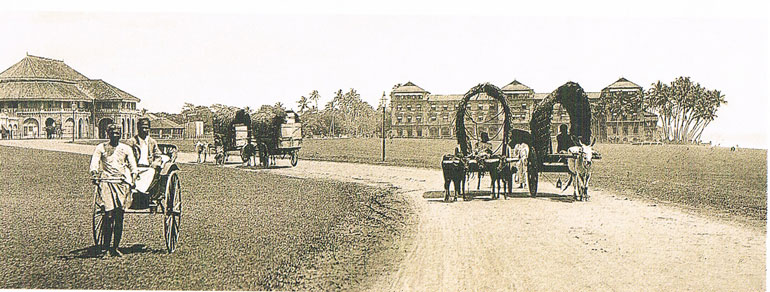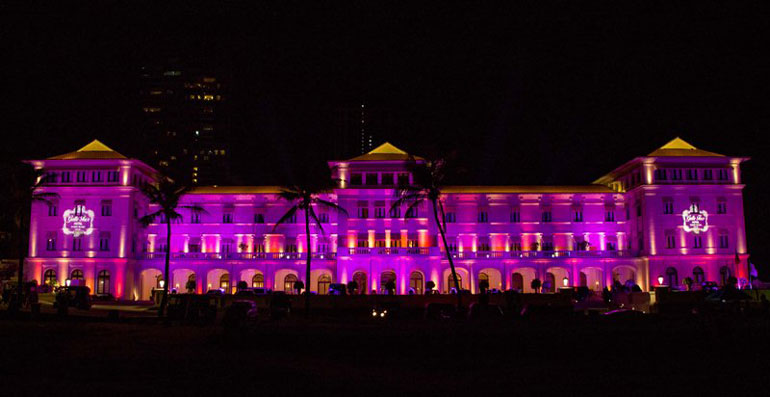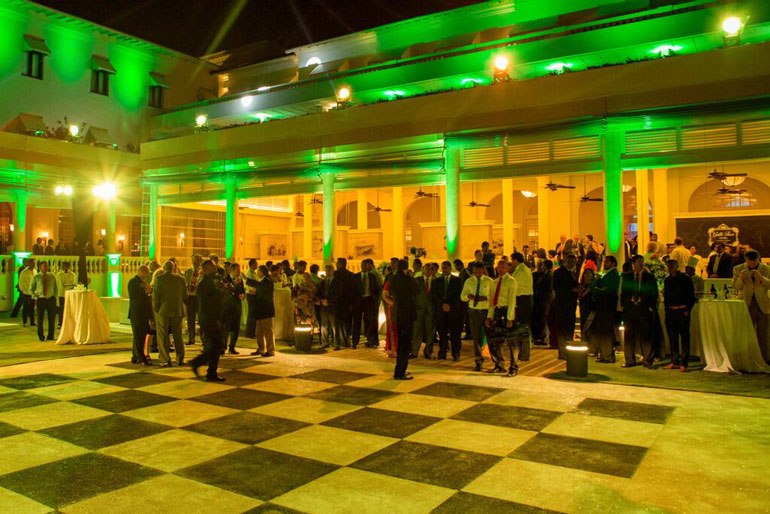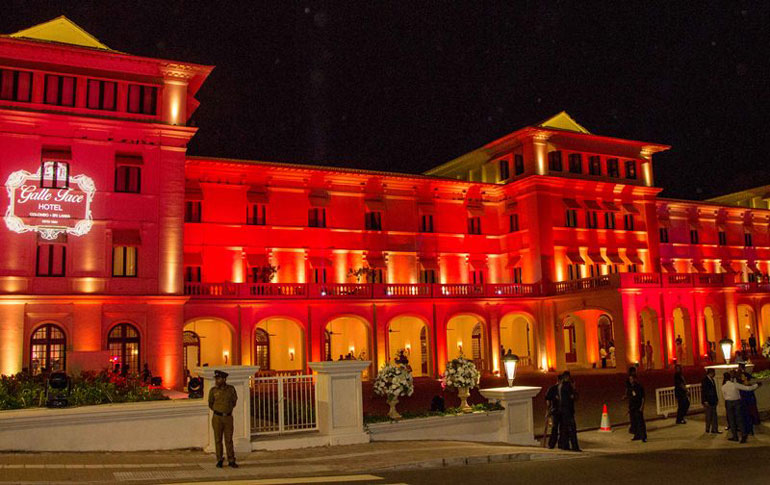Wednesday Feb 12, 2025
Wednesday Feb 12, 2025
Saturday, 7 November 2015 00:10 - - {{hitsCtrl.values.hits}}


By D.C. Ranatunga
Double bullock carts (‘bara karatta’) on the Galle Face Centre Road! Would you believe it? You have to! A.W. Plate’s picture with the Galle Face Hotel (GFH) at the far end is proof of it. Just a little over 100 years ago, the ‘bara karatte’ drawn by two bulls as well as the ‘bara naage’ – the smaller version drawn by a single bull (also seen in the picture) were used to transport goods. Even with modern modes of transport, these carts are still being used in rural Sri Lanka.
I came across the picture as I started hunting for news about the origin of the Galle Face Hotel having read about the opening of the refurbished GFH recently.
The picture along with another from a picture postcard released by Plate & Company of the Hotel has been reproduced in ‘Images of British Ceylon’ featuring the 19th century photography of Sri Lanka co-authored by Ismeth Rahim and Percy Colin Thome. (Picture postcards of the early British times featured landmark sites, people, business areas and major crops.)
The write-ups on the pictures trace the history of the Galle Face Hotel to the 1850s when there were only two hotels in Colombo catering to the European community. The two were the Royal Hotel and Galle Face House. The first was in Fort and the other, as the name indicates, was at the southern end of the Galle Face Esplanade.
In the early 1860s a joint-stock limited liability company had been formed to manage the two hotels. The first such company to be established in Ceylon, its directors were a number of well-known Englishmen. Records indicate that the Colombo Hotel Company Ltd., as it was called, had acquired three properties in 1867. One was the Galle Face House which covered about two acres.
Galle Face House had been demolished in the mid-1880s and a new building erected in its place. Obviously that’s what we see today. There was a change in the name too – from Galle Face House to Galle Face Hotel.
The location of the Galle Face Hotel by the seaside facing the open air view of the Galle Face Green coupled with its old world charm has made it an iconic spot in the City. Until the middle of the 20th century when new hotels came to be built, GFH and GOH (Grand Oriental Hotel opposite the jetty) were the only big hotels where weddings and big receptions were held. GFH was the chosen site by the well-to-do families for weddings.
GFH boasts of the famous personalities who had stayed in the hotel. They range from royalty to astronauts, film stars, writers and many more. It has been often quoted that Sir Arthur C Clarke wrote the final chapters of ‘3001 – The Final Odyssey’ in the hotel.
I remember organising the first Regional Conference of Singapore-based AMIC (Asian Mass Communication Research & Information Centre) in 1970 at the GFH and getting Sir Arthur to deliver the keynote address. (I happened to be the first AMIC correspondent in Sri Lanka.) At a time when there were no laptops or Power Point, he used his Kodak slide projector for the presentation. AMIC delegates from several countries stayed at the GFH and were quite pleased with the service and environment.
During the days I was with CTC, we found GFH to be an ideal location for events where a limited number was invited. Once CTC sponsored the launch of Thilak Samarawickrema’s ‘Andare’ where the chief guest was Minister Anandatissa de Alwis. In his inimitable style Thilak created a simple and elegant hall decoration using ‘araliya’ flowers. We also had a Khemadasa concert one evening with Minister Gamini Dissanayake as the chief guest.
The first coffee table book authored by me along with designer Somachandra (Ruwan) Peiris and photographer Sarath Perera for the Buddhist Publication Society (BPS) – ‘The Great Revival’ to commemorate the 250th anniversary of the restoration of ‘upasampada’ (higher ordination) in Sri Lanka, was launched at GFH. Our second effort, ‘From the Cradle’ – on folk culture based on the Martin Wickramasinghe Museum at Koggala was also launched there.
Origins
As for the origins of Galle Face, the name had been in use from the days the Dutch occupied the maritime provinces. Renowned writer, Sir James Emerson Tennent mentions in his exhaustive volume ‘Ceylon’ that Galle Face in Dutch was ‘Galle-faas’, the ‘fass’ or front, of the fortification facing the direction of Galle.
According to R.L. Brohier, in the early days of British occupation, Galle Face served as the main exercising ground of the garrison.
“Rather curiously, military executions too were enacted there, just outside the Fort and overshadowed by the ‘South Gate’ walls. Records tell of four military executions – of Private John Gould in 1810 for mutiny at Galle; of Private John Stevenson in 1814 for mutiny; and Private John Jenny and John Matterson in 1817 and 1833 respectively, in both instances for mutinous conduct and striking officers. It is indeed a coincidence that these four unfortunate men were all called John,” writes Brohier in ‘Seeing Ceylon’.
John Deschamps, an Adjutant in the Royal Artillery, described Galle Face as “not only the principal exercising ground of the garrison, but also the general promenade of the inhabitants of Colombo and its vicinity, who repair thither morning and evening on foot, on horseback, or in carriages, to inhale the delicious breeze which is almost always to be found by the sea-side of this part of the Island.”
Galle Face was turned into a racecourse in 1829 during the time of Governor Sir Edward Barnes (1824-1831), who was a great lover of horse-racing. It was then a swamp and was filled and levelled and turned into the ‘Colpetty Race Course’, described as a good course of a mile and a quarter round.
The circular race-stand, in the words of Deschamps, was “a substantial building of brick, coated with a plaster of ‘chunam’, a preparation of shell and common lime; the roof, which is of conical shape, is covered with ‘kedjhans’ (cadjans) made of coco-nut leaves – which form an excellent thatch – and projects over the verandahs on the ground and upper floors, from the latter of which a capital view of the whole course is obtained. The race-balls are held here, the upper room being cool and airy for dancing; card-tables are placed in the verandahs, whilst the lower portion forms a good supper-room.”
A British company called the Assembly Company Rooms Ltd. built a small oval shaped building which came to be known as ‘The Race Bungalow’. It was later to become the home of the Colombo Club, “a most exclusive, men only club, where business deals were discussed at cold tiffins or at the bar.” Later Hotel Taj Samudra came to be built at the premises, yet the original building was kept intact and is presently used as the Crystal Ballroom.
Governor Sir Henry Ward (1855-60) built the promenade skirting the sea-front at Galle Face while Lady Ward named the one mile long open lawn the ‘Galle Face Green’. Governor Ward constructed the ‘Galle Face Walk’ because red dust from the cabook soil was blown about by the sea breeze and the place became unpleasant.

Timeless grandeur 
The magnificient checkerboard  The hotel in all its glory
The hotel in all its glory
Discover Kapruka, the leading online shopping platform in Sri Lanka, where you can conveniently send Gifts and Flowers to your loved ones for any event including Valentine ’s Day. Explore a wide range of popular Shopping Categories on Kapruka, including Toys, Groceries, Electronics, Birthday Cakes, Fruits, Chocolates, Flower Bouquets, Clothing, Watches, Lingerie, Gift Sets and Jewellery. Also if you’re interested in selling with Kapruka, Partner Central by Kapruka is the best solution to start with. Moreover, through Kapruka Global Shop, you can also enjoy the convenience of purchasing products from renowned platforms like Amazon and eBay and have them delivered to Sri Lanka.
Discover Kapruka, the leading online shopping platform in Sri Lanka, where you can conveniently send Gifts and Flowers to your loved ones for any event including Valentine ’s Day. Explore a wide range of popular Shopping Categories on Kapruka, including Toys, Groceries, Electronics, Birthday Cakes, Fruits, Chocolates, Flower Bouquets, Clothing, Watches, Lingerie, Gift Sets and Jewellery. Also if you’re interested in selling with Kapruka, Partner Central by Kapruka is the best solution to start with. Moreover, through Kapruka Global Shop, you can also enjoy the convenience of purchasing products from renowned platforms like Amazon and eBay and have them delivered to Sri Lanka.